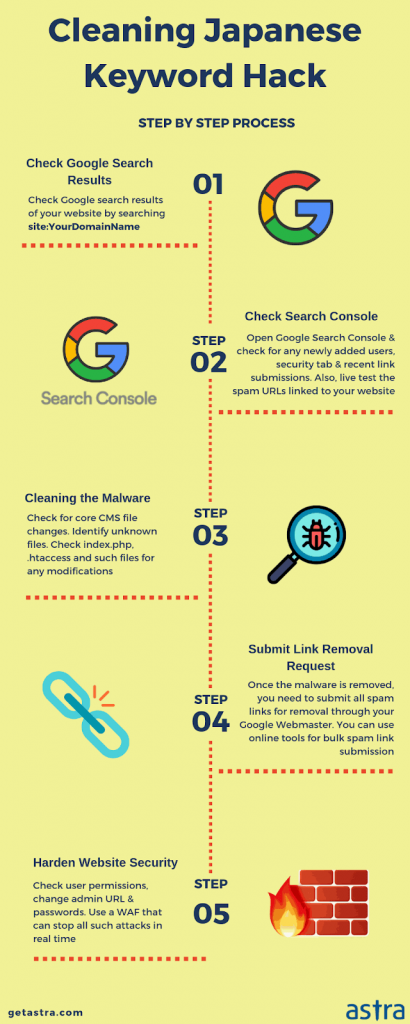If your website’s search results are filled with Japanese keywords, your website might be in trouble. In Japanese Keyword Hack, hackers create multiple new pages with auto-generated Japanese keywords to spam your website. It is also famous as Japanese SEO spam. To know more about Japanese SEO spam, stay tuned. In the upcoming sections, we will discuss everything you need to know about this hack.

Example of Japanese keyword hack; Image source: Astra Security
Japanese keyword hack: What is it?
More than 51% of the hacked websites are results of SEO spam. There are different types of SEO spam available, but one of the most persistent ones is the Japanese keyword hack. In this hack, Japanese keywords automatically appear in the title and description portion of the hacked websites or pages. It is a type of black hat SEO technique used by hackers to manipulate your website’s SEO settings and make a profit via your reputation. These websites are often injected with links to fake merchandise’s websites. These outbound links are used to rank illegal and fake websites and earn revenue from them.
What is the effect of Japanese SEO spam on websites?
A cyber-attack in any form acts as a massive setback for any website. A cyber attack will not only cause you revenue loss, but you can also lose your valuable customers. Once the reputation of a website goes down, it isn’t easy to pick it back up. Some of the ever-lasting damages of a Japanese keyword hack are:
- Blacklisting of website.
- The hosting company of your website might suspend you.
- Loss of revenue and clients.
If you do own a website, the consequences of these effects must be clear to you. To avoid these consequences, you need to remove the hack and safeguard your website against it. But before that, you must make sure that your website is indeed a victim of Japanese SEO spam.
How to confirm SEO spam?
Use a malware scanner
There are several ways to confirm if there has been a hack on your website or not. One of the best ways is by using a malware scanner. There are multiple malware scanners you can choose from. Take Astra security; for instance, it is one of the most trustworthy scanners available. And it is easy to use. All you have to do is enter your website’s URL and leave the rest to them.
Use Google search engine to identify the hack
Another way to identify the hack is by Google searching your website using the syntax: site:[your website URL] japan. This search will show you the pages of your website that contain the keyword Japan. If there are pages present on your website with the keyword ‘japan’, your website is a victim of a Japanese keyword hack.
Use Google Search Console
You can use the Google search console to confirm the SEO spam hack on your website. Log in to the console, go to the ‘Security Issues Tool’ tab, and check the related results. The results will show you if there is any Japanese keyword on your website.
How to fix the Japanese keyword hack?
Now that we have discussed the Japanese keyword hack in detail, all there is left to do is fix it. The base of fixing a hack comes down to removing and cleaning all the source files and SEO spam folders..
There are two ways to fix a hack, either manually or professionally. Although we will discuss both ways, it is always better to get professional help while cleaning your website. Because it can get too technical at some point, and if you are not used to technical terms and processes, you might end up ruining your website.
1. Take a backup!
This is not essentially a step to fix the hack, but it is just as important. Trust me; you would not want to start your website from scratch if you accidentally delete your core files. Therefore, take a backup of every file and folder that you think is worth saving.
2. Verify new users
Google search console contains all the information of a website. Therefore, go to the console, and look for any suspicious and unauthorized user with access to the admin area. If you do find any suspicious user, remove him/her.
3. Check .htaccess file
The .htaccess file of a website contains all the website’s essential data; hackers can use it to redirect users to malicious links. Therefore, compare the infected .htaccess file of your website with the last clean backup. If you find any suspicious codes and scripts, comment them out using ‘#’ or, better, remove them. You can also skip this step and replace the infected file entirely with the backup file.
4. Remove malicious files
Go to your website’s uploads directory and look for the files with blacklisted extensions such as ‘.ico’, ‘.php’, or ‘.js’. These files are mostly malicious; therefore, delete them!
5. Replace all the files with the factory version
This is the step where taking the backup will come in handy. All you have to do is replace the infected core, theme, and plugin files with their factory version or their backup version. It will save you a lot of time!

How to get rid of the Japanese Hack; Image source: Astra Security
Professional Help!
You must have realized why we recommend professional help. These steps might look easier while reading, but you won’t know while performing the tasks manually which file to remove and which file to replace. This is why Astra security is the best option for you. You have to sit back and let them do their work or use their security solution to harden the security of your website.
If you have further questions regarding the Japanese keyword hack, feel free to contact us!
